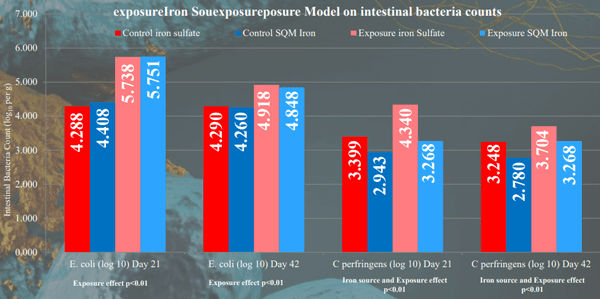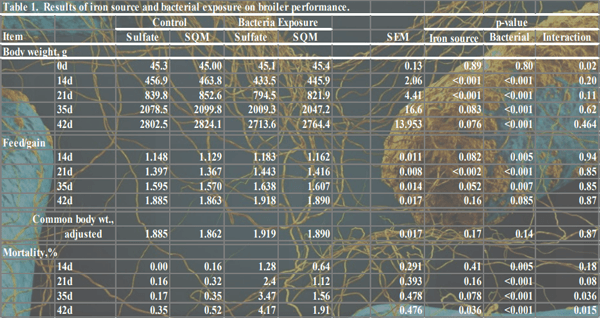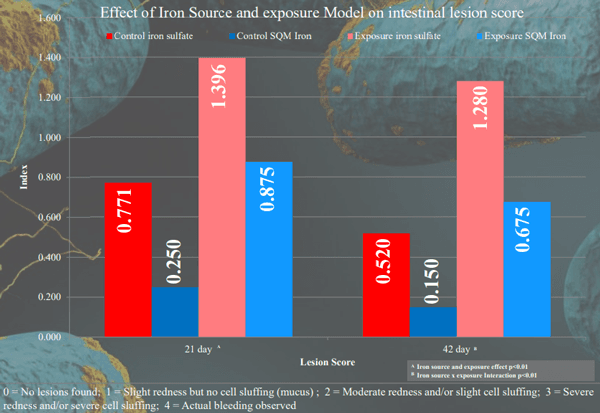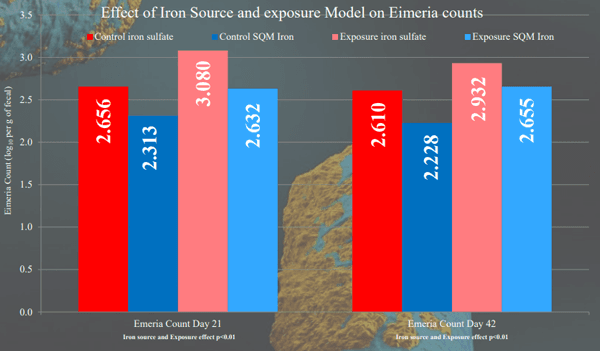Influence of Iron Source (Organic vs Inorganic) on Broiler Performance Under a Pathogen Exposure
Iron is a trace mineral supplemented in broiler diets. Bacterial pathogens, such as E. coli, C. perfringens and E. acervulina have an essential requirement for iron such that they have multiple sequestering mechanisms to obtain iron. This study was designed to evaluate the hypothesis that an organic form of iron (SQM Iron®, QualiTech, Inc.) could limit the availability of iron to such pathogens and reduce their impact on broiler performance. A total of 2496 mixed sex broiler chickens (Ross 708) were randomly assigned to one of 48 pens (12 pens/replicate). Diets (corn-soy based) were formulated to meet industry standards for a Prestarter (0-7d), Grower (8-35d) and Finisher (36-42d) program. Treatments included 1) iron sulfate as the sole supplemental iron source (IONC), 2) SQM Iron instead of iron sulfate (OINC), 3) IONC receiving a pathogen exposure on day 7 (IOPC), and 4) OINC receiving a pathogen exposure on day 7 (OIPC). Broilers received Cocci-Vac day 0. Sub-clinical exposure was provided by obtaining used litter containing E. acervulina (>50,000 oocysts/bird), C. perfringens (>104/bird) and E. coli (>106/bird). Performance was measured every 7 days; lesion scoring, and bacterial counts were done on day 21 and 42. Broiler growth rate and efficiency was significantly (p<0.085) impaired by the pathogen exposure every week of the study. Iron source had a significant (p<0.05 improvement on weight and efficiency through week 3 with the organic iron source. Week 4-6 had strong trends for organic source improving bird weight and efficiency. Bird mortality showed a significant (p<0.05) interaction between source and expose with those bird receiving the organic source reducing mortality under the exposure conditions. Lesion scores were significantly (p<0.01) reduced by feeding the organic iron source (exposed or unexposed). Iron source had no influence on E. coli counts. Feeding the organic iron source significantly (p<0.01) reduced C. perfringens and cocci counts at all times of the study. Results of this study showed that feeding SQM Iron as an organic iron source reduced the growth rate of pathogens. This reduction in growth rate appears to be due to limiting the accessibility of iron for growth of pathogens.
- E. coli accumulate large amounts of iron via multiple transport systems including enterochelin transport system (McIntosh and Earhart, 1977).
- Three tetracyclines were found to possess iron-chelating activity as part of the antibiotic activity. (Greinier et al., 2000)
- Clostridium perfringens produced larger colonies, with…ferredoxin, than that on the control medium. (Osman et al. 2013)
- Proposed that increasing iron concentration may thus lead to an increase in E. coli growth. (Appenzitter et al. 2005)
- Research showed that maximum growth for E. coli occurred at 0.6 mg. ferrous ion/l. medium. (Pappenheimer & Shaskan, 1944)
- E. coli growth was not affected by increases beyond 0.6 mg/l up to 90 mg./l. (Fuchs and Bonde, 1957)
- Numerous studies have assessed the potential viability of iron-chelators as therapeutic agents against various microbes…. (Thompson et al., 2012)



- 2x2 factorial arrangement of treatments (Iron source x bacterial exposure)
- Iron sulfate vs SQM Fe; 20 ppm
- Control litter vs contaminated litter
- 2,496 mixed sex broiler chicks
- 48 pens total (52 chicks/pen)
- Starter (0-7 day), Grower (8-35 day), and Finisher (36-42 day).
- Mash form were based on corn and SBM.
- 42-d study, measurements 7, 14, 21, 35 and 42 days.
- The sub-clinical exposure (built-up litter and moderate stress conditions via bacterial and coccidial exposure), relating to age of litter (a minimum of three previous flocks), was obtained with built-up litter, containing a mixture of coccidia E. acervulina (>50,000 oocysts/bird), Clostridium perfringens (>104 per bird) and E. coli (>106 per bird) bacteria were administered into the litter on Day 7.


- SQM Iron maintained the performance of broilers when exposed with microbial pathogens.
- The mode of action appears to be providing a highly bioavailable source of iron to the broilers while reducing the ability of microbial pathogens to utilize that same iron source for growth.
- Therefore, to reduce the impact of a subclinical microbial infection include SQM Iron in your trace mineral fortification program.
Ibrahim,
Thank you for your question. The calculated iron content of the basal diets came out to be about 70 ppm. And so our treatments were 20 ppm additional added to those diets. In earlier research that we conducted, it showed that these type diets needed supplemental iron. The industry values for supplementation, that we have found, range from 20 to 60 ppm additional iron. We chose to go with the lower inclusion rates in this study. One of the other considerations is "How available is the iron from the feed sources?" Very little research I have been able to find has shown iron bio-availability for individual feed-stuffs. What I have found is that if the iron is in the ferric form it is poorly available and if it is in the ferrous from it is more available. Soil contamination and most sources (not of animal origin) are in the ferric form, thus low available iron. I hope this information helps.
Dear Jack Garrett!
You state that: "Research on multiple chelated products in the market is absolutely necessary for the scientific community, but not necessary for individual companies to conduct."
But how can you prove that your product is better than the competitor's?
Dear authors Jack Garrett and others!
Your work, regardless of the results, is of great importance, as it helps to develop a new line of research on the use of organic compounds of trace elements. Their role can not be seen exclusively in improving the availability of minerals for animals, perhaps in some cases this is not even the main thing. This assumption is confirmed only by the different effectiveness of their use, which is registered in hundreds of experiments.
Specifically to your work, I want to note that the effectiveness of organic sources of iron will depend on the stability of the compounds used. Please repeat the research and test the effect of iron chelates with low (6-8), medium (11-14) and high (20-30) stability constants. You will get original new information. I wish you success.
It seems good but let discuss more and more in detail and then evaluate the performance of the chickens. And what about the other elements such as Selenium, and vit E, also not only the performance should also evaluate the enzymes those found with in the chickens body.
















.jpg&w=3840&q=75)